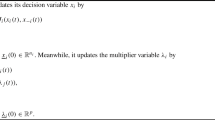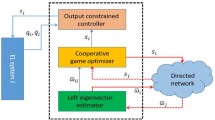Abstract
In this paper, we investigate a continuous-time distributed Nash equilibrium seeking algorithm for a class of aggregative games, with application to the real-time pricing demand response. To seek the Nash equilibrium via local communication among neighbors, by combining projected gradient dynamics and consensus tracking dynamics, we propose a novel distributed algorithm for the players. We prove the convergence of the distributed algorithm via a constructed Lyapunov function and the variational inequality technique, and show an illustrative simulation related to the energy consumption control in smart grids.
Similar content being viewed by others
References
M. K. Jensen, “Aggregative games and best-reply potentials,” Economic Theory, vol. 43, no. 1, pp. 45–66, 2010.
R. Cornes, “Aggregative environmental games,” Environmental & Resource Economics, vol. 63, no. 2, pp. 339–365, 2016.
H. Yin, U. V. Shanbhag, and P. G. Mehta, “Nash equilibrium problems with scaled congestion costs and shared constraints,” IEEE Transactionson on Automatic Control, vol. 56, no. 7, pp. 1702–1708, 2011.
L. Chen, N. Li, S. H. Low, and J. C. Doyle, “Two market models for demand response in power networks,” Proceedings of the 1st IEEE conference on Smart Grid Communications, Gaithersburg, MD, USA, pp. 397–402, Oct. 2010.
C. Wu, H. Mohsenian-Rad, and J. Huang, “Vehicle-to-aggregator interaction game,” IEEE Transactions on Smart Grid, vol. 3, no. 1, pp. 434–442, 2012.
Z. Ma, D. S. Callaway, and I. A. Hiskens, “Decentralized charging control of large populations of plug-in electric vehicles,” IEEE Transactions on Control Systems Technology, vol. 21, no. 1, pp. 67–78, 2013.
K. Ma, G. Hu, and C. J. Spanos, “Distributed energy consumption control via real-time pricing feedback in smart grid,” IEEE Transactions on Control Systems Technology, vol. 22, no. 5, pp. 1907–1914, 2014.
D. Paccagnan, B. Gentile, F. Parise, M. Kamgarpour, and J. Lygeros, “Distributed computation of generalized Nash equilibria in quadratic aggregative games with affine coupling constraints,” Proceedings of 55th IEEE conference on decision and control, Las Vegas, USA, pp. 6123–6283, Dec. 2016.
S. Grammatico, “Dynamic control of agents playing aggregative games with coupling constraints,” IEEE Transactionson on Automatic Control, vol. 62, no. 9, pp. 4537–4548, 2017.
S. S. Kia, J. Cortés, and S. Martínez, “Distributed convex optimization via continuous-time coordination algorithms with discrete-time communication,” Automatica, vol. 55, pp. 254–264, 2015.
J. Liu, W. Chen, and H. Dai, “Sampled-data based distributed convex optimization with event-triggered communication,” International Journal of Control, Automation and Systems, vol. 14, no. 6, pp. 1421–1429, 2016.
X. Wang, Y. Hong, P. Yi, H. Ji, and Y. Kang, “Distributed optimization design of continuous-time multiagent systems with unknown-frequency disturbances,” IEEE Transactions on Cybernetics, vol. 47, no. 8, pp. 2058–2066, 2017.
F. Parise, B. Gentile, S. Grammatico, and J. Lygeros, “Network aggregative games: Distributed convergence to Nash equilibria,” Proceedings of 54th IEEE conference on decision and control, Osaka, Japan, pp. 2295–2300, Dec. 2015.
J. Koshal, A. Nedić, and U. V. Shanbhag, “Distributed algorithms for aggregative games on graphs,” Operations Research, vol. 63, no. 3, pp. 680–704, 2016.
S. Liang, P. Yi, and Y. Hong, “Distributed Nash equilibrium seeking for aggregative games with coupled constraints,” Automatica, vol. 85, pp. 179–185, 2017.
M. Ye and G. Hu, “Game design and analysis for price-based demand response: an aggregate game approach,” IEEE Transactions on Cybernetics, vol. 47, no. 3, pp. 720–730, 2017.
B. Gharesifard, T. Basar, and A. D. Dominguez-Garcia, “Price-based coordinated aggregation of networked distributed energy resources,” IEEE Transactions on Automatic Control, vol. 61, no. 10, pp. 2936–2946, 2016.
C. Godsil and G. Royle, Algebraic Graph Theory, Springer-Verlag, New York, 2001.
B. Li, H.-Y. Yang, Z.-Q. Chen, and Z.-X. Liu, “Distributed containment control of multi-agent systems with general linear dynamics and time-delays,” International Journal of Control, Automation and Systems, vol. 16, no. 6, pp. 2718–2726, 2018.
J.-B. Hiriart-Urruty and C. Lemaréchal, Convex Analysis and Minimization Algorithms I: Fundamentals, Springer-Verlag, Berlin Heidelberg, 1993.
F. Facchinei and J. Pang, Finite-Dimensional Variational Inequalities and Complementarity Problems, Springer-Verlag, New York, 2003.
M. Fukushima, “Equivalent differentiable optimization problems and descent methods for asymmetric variational inequality problems,” Mathematical Programming, vol. 53, pp. 99–110, 1992.
J.-l. Zhang, D.-l. Qi, and M. Yu, “A game theoretic approach for the distributed control of multi-agent systems under directed and time-varying topology,” International Journal of Control, Automation and Systems, vol. 12, no. 4, pp. 749–758, 2014.
Y. Yuan and F. Sun, “Data fusion-based resilient control system under dos attacks: A game theoretic approach,” International Journal of Control, Automation and Systems, vol. 13, no. 3, pp. 513–520, 2015.
J. S. Vardakas, N. Zorba, and C. V. Verikoukis, “A survey on demand response programs in smart grids: pricing methods and optimization algorithms,” IEEE Communications Surveys & Tutorials, vol. 17, no. 1, pp. 152–178, 2015.
M. H. Albadi and E. El-Saadany, “A summary of demand response in electricity markets,” Electric Power Systems Research, vol. 78, no. 11, pp. 1989–1996, 2008.
L. Chen, N. Li, L. Jiang, and S. H. Low, “Optimal demand response: Problem formulation and deterministic case,” in Control and Optimization Methods for Electric Smart Grids, pp. 63–85, Springer, New York, 2012.
L. Gelazanskas and K. A. Gamage, “Demand side management in smart grid: a review and proposals for future direction,” Sustainable Cities and Society, vol. 11, pp. 22–30, 2014.
J. S. Shamma and G. Arslan, “Dynamic fictitious play, dynamic gradient play, and distributed convergence to Nash equilibria,” IEEE Transactions on Automatic Control, vol. 50, no. 3, pp. 312–327, 2005.
X. Zeng, P. Yi, Y. Hong, and L. Xie, “Continuous-time distributed algorithms for extended monotropic optimization problems,” 2016, arXiv:1608.01167.
H. K. Khalil, Nonlinear Systems, 3rd ed, Prentice Hall, Upper Saddle River, 2002.
Author information
Authors and Affiliations
Corresponding author
Additional information
Publisher’s Note Springer Nature remains neutral with regard to jurisdictional claims in published maps and institutional affiliations.
Recommended by Associate Editor Shun-ichi Azuma under the direction of Editor Yoshito Ohta. This work is supported by National Natural Science Foundation of China (61873029, 61273090) and Beijing Natural Science Foundation (4192068).
Yawei Zhang received his B.E. degree in automatic control from the Nanjing Normal University in 2014. He is currently a Ph.D student in the Department of Automation, University of Science and Technology of China. His research interests include distributed Nash game and distributed optimization.
Shu Liang received his B.E. degree in automatic control and a Ph.D. degree in engineering from the University of Science and Technology of China, Hefei, China, in 2010 and 2015, respectively. He was a postdoctoral fellow at Academy of Mathematics and Systems Science, Chinese Academy of Sciences from 2015 to 2017, and was a visiting scholar at Wayne State University from 2017 to 2018. He is currently a lecturer in the School of Automation and Electrical Engineering, University of Science and Technology Beijing, China. His research interests include distributed optimizations and fractional order systems.
Haibo Ji was born in Anhui, China, in 1964. He received his B.Eng. degree and Ph.D. degree in Mechanical Engineering from Zhejiang University and Peking University, in 1984 and 1990, respectively. He is currently a Professor in Department of Automation, University of Science and Technology of China. His research interests include nonlinear control and its applications.
Rights and permissions
About this article
Cite this article
Zhang, Y., Liang, S. & Ji, H. Distributed Nash Equilibrium Seeking for Aggregative Games via Derivative Feedback. Int. J. Control Autom. Syst. 18, 1075–1082 (2020). https://doi.org/10.1007/s12555-019-0011-y
Received:
Revised:
Accepted:
Published:
Issue Date:
DOI: https://doi.org/10.1007/s12555-019-0011-y




